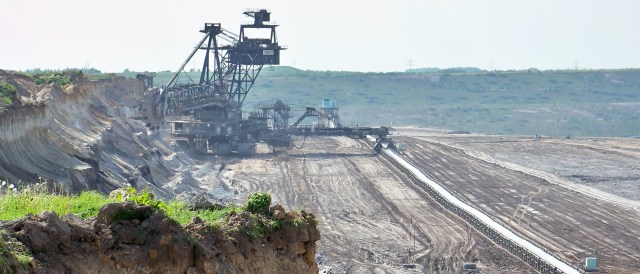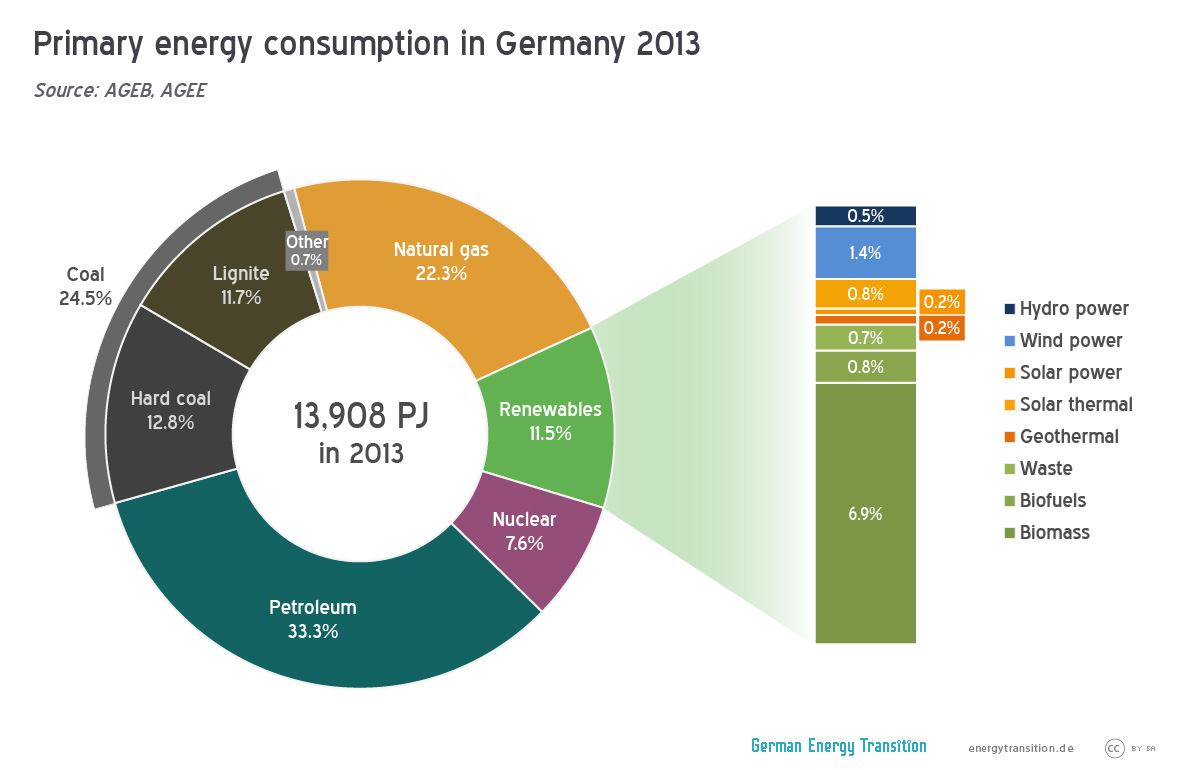How much of its energy does Germany cover from solar energy, and how much of it comes from lignite? Before you read Craig Morris’s answers, go ahead and take a guess. Maybe you read a number recently?

Is lignite really Germany’s primary energy source as Deutsche Welle claims? (Photo by Joeb07, CC BY 3.0)
Deutsche Welle put it clearly last year: “Lignite is still Germany’s primary energy source.” Or is it so clear? Let’s take a look at this chart based on official data:
As we see, the largest source of energy as a part of demand is clearly petroleum, followed by natural gas. Lignite comes in fourth behind hard coal. If we take hard coal and lignite together as coal, then coal squeaks past natural gas to come in second. How did Deutsche Welle get it so wrong?
A number of errors are frequently made in this context. First, people confuse energy and electricity. Electricity makes up around 20 percent of energy consumption in Germany (compared to 40 percent in the US). The Germans consume the other 80 percent in the transportation and heat sectors, with much of it being oil and gas.
Another frequent distinction that gets overlooked is between peaks and averages. When renewable electricity peaked at around 73 percent of power consumption briefly one day this year, we suddenly saw reports that “Germany gets three quarters of its energy from renewables.” Such a statement conflates peaks and averages along with energy and electricity.
But Deutsche Welle did not confuse those things. There is one sentence in the article that helps shed light on the issue: “Germany produces more than 15 percent of its energy by burning lignite coal.” 15 percent is pretty close to the 12 percent in the chart above, so the article is probably talking about primary energy consumption. The article thus does not indicate what the headline gets wrong.
What we can say, though the chart does not show it, is that lignite is the biggest source of domestic energy in Germany. Almost all the other conventional energy (including uranium for nuclear plants) is imported. Otherwise, we can say several things based on the chart above:
- The share of renewables is greater than nuclear, even when we exclude hydropower.
- Indeed, the share of bioenergy (nearly half of which is waste in Germany) alone is larger than nuclear. (That’s true worldwide as well, incidentally.)
- The share of solar (photovoltaics and solar thermal) in energy supply is around one percent.
- Renewables made up close to 12 percent of German energy consumption in 2013.
- Wind and solar power together make up only 2 ½ percent of German energy consumption.
What lessons do we draw? Nothing new, really. First, that Germany’s Energiewende desperately needs to start addressing the transportation and heat sectors – but we already knew that. And second, don’t believe everything you read (except here, of course).
Craig Morris (@PPchef) is the lead author of German Energy Transition. He directs Petite Planète and writes every workday for Renewables International.


Interesting numbers, especially in the light of German target of 60% of primary energy in 2050.
Assuming that energy consumption is cut 50%, hydro stays the same and nuclear is replaced by additional bioenergy, this would mean that wind and solar would have to generate roughly 10 times more energy in 2050 than today. That would require around 700 GW of PV and wind capacity if you just multiply the current numbers.
There is a point that is overlooked in this article: Not all primary energy is created equal. For fossil fuels the primary energy is the heat released when burning the fuel. This heat has to be converted to electricity with losses of over 50%. For renewable energy sources the electricity output is counted as primary energy. This means that primary renewable energy is twice as useful as primary coal and lignite.
Comparing primary energy use of fossil and renewable energy sources is thus comparing apples and pears. It would make more sense to compare “final energy”, i.e. the form of energy that is used by the end-user.
As for the headline, presumably they mean largest domestic energy source, which is sadly true.
Thanks for pointing out the differences between peaks and averages and electricity and energy. Not many renewabls enthusiasts do that.
Question on bioenergy: You claim that nearly half (44%) is from waste, but the link only refers to biogas. As far as I know liquid biofuels are 100% from crops and how much of wood pellets are from waste is also questionable, given that half the wood harvest is being burned in Germany.
On nuclear power, it is true that 100% of uranium is imported, but 2500 tons at a market value of 180 million Euros is enough for the current 100TWh annual generation.
That is a fuel cost of 0.0018 Euro/kWh. The fuel cost for coal is at least 12 times more. So even with 100% of lignite and 20% of hard coal mined domestically, the average import cost for coal power is much higher for coal than for nuclear.
Also the low cost and enormous density of uranium as fuel makes it practical and cheap to stockpile several years worth of demand if you worry about supply security.
Therefore nuclear power is for all practical purposes, a domestic energy source.
Breeder reactors would obviously remove the dependence on newly mined uranium completely, but only if they are actually used and not converted to sodding amusement parks.
[…] What German energy supply looks like […]